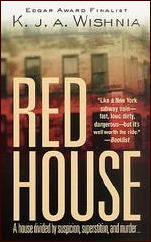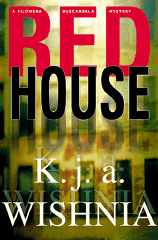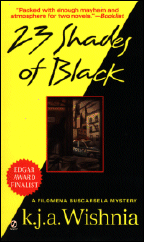Mon 29 Dec 2008
Archived Review: K. j. a. WISHNIA – Red House.
Posted by Steve under Authors , Bibliographies, Lists & Checklists , Characters , Crime Fiction IV , ReviewsNo Comments
K. j. a. WISHNIA – Red House.
St. Martin’s; paperback reprint, December 2002. Hardcover edition: St. Martin’s, November 2001.

This is the fourth in the series of mysteries solved by Ecuadorian ex-revolutionary and now fledgling private eye Filomena Buscarsela, single mom and philosopher slash social critic. Quoting from page 67: “And thus we see the dangers of post-Heideggerian rejection of history.”
Since I haven’t read the previous three books, I don’t know exactly what career paths she may have been following up to now. She seems to have spent some time on the New York City police force — a police detective for only one day, as she puts it — but in this book, she’s a first year trainee at the PI firm of Davis and Brown, trying to work her way up to getting her own license.
And rather than focusing on only one case, we get bits and pieces of a number of them — more of a private eye procedural, a la Joe Gores, street style, as Filomena tries to build up the Latino clientele for the firm.
The mugging (murder?) of a local housing advocate is the main item on her agenda, however, with the plight of the illegal squatters in an abandoned tenement they refurbished themselves a close second.
The pace is fast-moving, told in first person, present tense, and Filomena certainly knows her way around. The problem with the book is a subtle one, as I found it. According to the back cover, Wishnia (male) has a Ph.D. in comparative literature, and book reads as though it was written by someone having a Ph.D. in comparative literature.

It does not read as though it was being told by a real-life Filomena Buscarsela, whose depth of knowledge seemingly knows no bounds, running the gamut from Heidegger (see above) to Marx (Groucho, waggle-waggle) to pulp novel covers (page 131) to nineteenth-century German chemist Friedrich Kekulé (page 226).
I’m not saying that Filomena Buscarsela is not the person she says she is. What I’m saying is that K. j. a. Wishnia did not succeed in convincing me that she is. It’s his job, and so far (I’ve read only the one book) he hasn’t done it, at least not for me.
The street scenes are fine, perhaps even more than fine. Otherwise? I’m skeptical, but I’ll leave myself open to opposing argument. (Even better, I’ll read the first three books.)
[UPDATE] 12-29-08. That’s another promise I haven’t kept, I’m sorry to say. Not yet, I haven’t, but I will. For the record, expanded upon from her entry in the Revised Crime Fiction IV, by Allen J. Hubin, here’s a list of all of Filomena’s appearances in book form:
BUSCARSELA, FILOMENA
23 Shades of Black. The Imaginary Press, trade pb, 1997. Signet, pb, Nov 1998; Point Blank, trade pb, 2004. [Edgar Award finalist for Best First Novel.]

Soft Money. Dutton, hc, 1999; Signet, pb, May 2000.
The Glass Factory. Dutton, hc, 2000; Signet, pb, Mar 2001.
Red House. St. Martin’s, hc, Nov 2001; St. Martin’s, pb, Dec 2002.
Blood Lake. St. Martin’s, hc, Dec 2002.